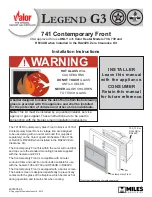
12
Put the helmet on and play preferably the same piece of music that you listened to earlier, and try to
focus on one speaker/side at a time, while moving the helmet up, down, backwards and forwards and
also side to side to listen for any improvements or loss of sound level and quality.
If for example, moving the helmet forwards (on one side) improves the sound level or quality for that
speaker, it means your speaker is set too far back, so readjust it forwards until any movement forwards
or backwards only reduces the sound quality/level and does not improve it, meaning that you have
found the best horizontal position for that speaker. Do the same for the other side and then test for up
and down.
If for example, moving the helmet up (on one side) improves sound level or quality for that speaker, it
means the speaker is set too low, so adjust the speaker upwards, and do this accordingly with each
speaker/side until you are happy that you have the best possible vertical and horizontal positioning for
each speaker.
If you now push the side of the helmet towards your head and notice improved sound, it means you
need to pack that speaker out on some foam so that it is nearer to your ear. Do this to both sides, and
then recheck each side for vertical (up, down) alignment and also again for horizontal (back and
forwards) and adjust each speaker until it cannot be improved.
Ensure the sound is equally balance to both ears, if it is slightly louder or has more bass in one ear it
means the other speaker is out of alignment (or need more packing out) until the sound from both
speakers are equal
Needless to say you will need to find the best compromise in both comfort and sound quality/level, and
your comfort will almost certainly be your top priority, however please remember that angling the
speakers as show in the diagram on page 7, and avoiding the top part of your ears will greatly help to
improve both positioning/sound level and quality while maintaining maximum comfort.
If you have a helmet that has virtually no tolerance for any speakers (very tight by your ears) you
should NOT CUT the polystyrene, and you will normally find that only a VERY SMALL amount of extra
space, or better speaker positioning would remove all the pressure and make the speakers comfortable.
Only if you have tried everything else
first, including asking your dealer for advice and/or help first,
should you use your thumb (or something harder, smooth and rounded like the back of a screwdriver
handle) to carefully compress JUST ENOUGH of the polystyrene for the speaker magnet to slightly
recess into the polystyrene to help relieve any pressure. This would NOT normally require more than
just 1 or 2 mm (
1
⁄
16
”) in an area no larger than the magnet on the back of each speaker.
It may take a little extra time now to get each speaker correctly positioned and fine tuned but it will
pay huge dividends in sound quality, high speed performance and comfort, especially if you intend using
high attenuation earplugs.
When you are convinced that you have fine tuned your speaker positioning to perfection in your first
helmet installation, you should now retest the other headset (that’s not been installed) and see if you
can hear any difference between the installed headset and the one held properly over your ears? It
really is worth every minute extra of your time to make the installed headset sound every bit as good
at the one held properly over your ears.
When you have completed your first helmet installation you will almost certainly find that it
is a lot easier and less time consuming installing and tuning your second helmet. But if it is
different or you have any doubts please ask your supplier for advice.
Top Tips (8)
Note you may need to slightly readjust your speakers for more comfort during your first ride out and
until they have settled in, or perhaps in time should they slide up in your helmet through putting
the helmet on and off.
If passing an approved Autocom dealer you can ask them if you can compare your headset
installation with their ear-defender demo/test headsets in the shop. It is a good idea to do this at
least once every six months just to check your speakers haven’t move over time through putting the
helmet on and off.
TESTING THE INSTALLATION AND FINE TUNING THE
SPEAKERS AND MICROPHONE POSITIONING
GETTING READY FOR YOUR FIRST TEST RIDE,
BEFORE INSTALLING ANY AUDIO LEADS/DEVICES
Double check the main control unit is firmly fixed in place and that both rider and passenger leads, and
power lead are secure. Ensure there are no pressure points trapping any of the cables where they come
from under the seat or any body panels etc.
Setting the Auto Volume pre-set Sensitivity Control
Set the rider and passenger’s master volume controls and the stereo music front/rear fader pre-set
control and auto volume pre-set sensitivity control all to their central positions, so that the pointers on
the end of each knob lines up with their corresponding pointers on the lid label. Set the rider and
passengers VOX pre-set sensitivity controls fully anti-clockwise (very high, to ensure the VOX will not
false trigger while testing and setting the automatic volume control).
Super Pro Auto Instructions 8/5/09 2:24 pm Page 12






































